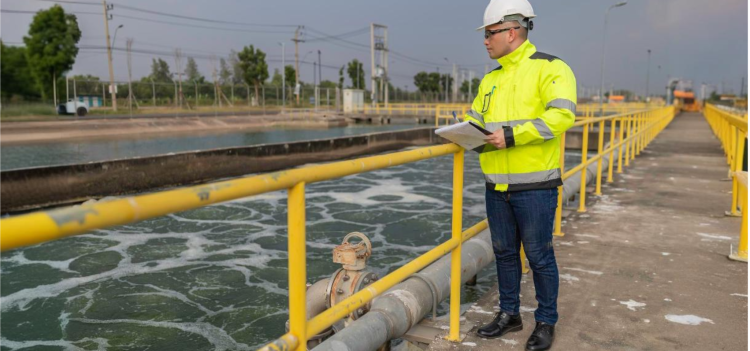Prolonging the Structure's Lifespan
- Avoiding Corrosion of Reinforcement: Contaminants like chlorides can accelerate the
corrosion of steel reinforcement bars within concrete. This corrosion reduces the structural
integrity of the building or infrastructure over time, requiring costly repairs or even
replacement. Testing water for these contaminants prevents such long-term damage by
ensuring only safe, non-corrosive water is used.
- Preventing Sulfate Attack: Water containing high levels of sulfate can cause sulfate attack in
concrete, leading to expansion and cracking. By testing for sulfates, construction teams can
avoid water that would lead to long-term damage and reduced structural lifespan.
Maintaining Construction Standards and Compliance
- Adherence to Building Codes: Many building codes and industry standards specify
acceptable levels for impurities in construction water, especially for concrete production.
Regular water testing ensures compliance with these codes and standards, which is essential
for passing inspections and avoiding legal issues.
- Certification and Quality Assurance: Many construction projects require quality certification.
Water testing is often part of this certification process, assuring clients and stakeholders that
the project meets established quality standards.
Optimizing Construction Processes
- Curing and Hydration Control: Water quality affects the curing process of concrete, which is
crucial for reaching the desired strength and durability. Impure water can alter the hydration
process, leading to incomplete curing and suboptimal strength. Testing ensures the water
used in curing promotes optimal hydration, producing concrete that meets its design
specifications.
- Reducing Efflorescence: Water containing high mineral content can lead to efflorescence,
which is the appearance of white, powdery deposits on the surface of concrete and masonry.
This is not only unsightly but can also indicate underlying chemical reactions that may
compromise the material's integrity. Testing helps prevent efflorescence by identifying water
that contains excessive dissolved minerals.
Environmental Protection
- Minimizing Pollution Risks: Construction sites often involve runoff, which can carry
contaminants into surrounding soil and water sources. By testing water and ensuring it’s free
of harmful substances, construction projects reduce their environmental impact, particularly
on nearby groundwater and ecosystems.
- Sustainable Construction Practices: Many construction companies aim to follow sustainable
and environmentally-friendly practices. By ensuring that the water used in construction is
clean and safe, companies can avoid polluting local environments and better align with
sustainability goals and certifications (e.g., LEED certification).
Cost Savings and Efficiency
- Reducing Repair and Maintenance Costs: Poor water quality can lead to structural
weaknesses and faster degradation, resulting in costly repairs and maintenance over time.
Testing the water quality at the outset prevents these issues, reducing long-term expenses
associated with structural damage.
- Optimizing Material Use: Using quality water helps maximize the performance of other
construction materials, such as cement, aggregates, and reinforcements. By avoiding
impurities that may react with these materials, construction teams ensure that materials are
used efficiently and effectively, preventing waste and additional costs.
- Preventing Project Delays: If water quality issues are identified after construction has
started, it may require rework, which can delay the project timeline. By testing water before
construction begins, teams can address any issues proactively, minimizing potential project
delays and keeping to schedule.
Protecting Worker Health and Safety
- Preventing Exposure to Hazardous Chemicals: Contaminated water can introduce harmful
chemicals that may pose health risks to workers, especially if used for dust suppression,
washing equipment, or other onsite applications. Testing ensures that water used on-site is
free from toxic substances that could endanger workers.
- Ensuring Safe Working Conditions: Water used for various construction activities, like
spraying to reduce dust, can impact the air quality around the site. Testing the water before
use ensures that any potential contaminants won’t become airborne, protecting the
respiratory health of workers and those in nearby areas.
Enhancing the Quality of Ancillary Activities
- Washing Aggregates and Equipment: Water used to wash aggregates or equipment should
also be free of contaminants, as residue can carry over into the concrete mix or other
construction materials. Testing ensures that water used for these activities doesn’t introduce
impurities into the construction process.
- Dust Suppression: Water is often sprayed on construction sites to suppress dust, helping to
reduce air pollution and improve visibility. Using clean water for dust suppression prevents
the introduction of harmful particles into the air, enhancing both worker safety and
environmental compliance.
Key Parameters to Test
Ensuring the quality of water used in construction is crucial for the durability and strength of concret
e structures. Here are some key parameters typically tested for construction water:
Ideal range is 6.5 to 8.51. Ensures the water is neither too acidic nor too alkaline.
Helps stabilize the pH level1. Ideal range is 50 to 200 mg/L.
High levels can cause corrosion of steel reinforcement1. Permissible limit is 500 to 1000 mg/L.
Can affect the setting and strength of concrete2. Permissible limit is 500 to 1000 mg/L.
Indicates the total concentration of dissolved substances. Ideal range is 1000 to 1500 mg/L.
Can affect the clarity and quality of water. Permissible limit is 500 mg/L.
Presence of organic materials can affect concrete setting and strength. Permissible limit is 200 mg/L.
High levels can affect the water's suitability for concrete mixing. Permissible limit is 3000 mg/L.
Measures the water's acidity level3. Permissible limit is 0.02N NaOH to neutralize 100 ml of water.
Ensures the water is free from unpleasant odors and tastes, which can indicate contamination.
Regular testing of these parameters helps ensure that the water used in construction meets the requi
red standards and does not compromise the quality and durability of concrete structures.
